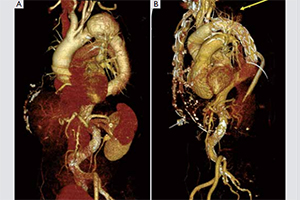Early- and medium-term results after aortic arch replacement with frozen elephant trunk techniques—a single center study
Abstract
Background: The treatment of patients with extensive thoracic aortic disease involving the arch and descending thoracic/thoracoabdominal aorta is often performed using the frozen elephant trunk technique (FET). We retrospectively analyzed our results of the FET operation.
Methods: A total of 51 consecutive patients underwent total aortic arch surgery with the FET technique between January 2006 and August 2013. For all patients, the E-vita hybrid open stent-graft (Jotec, Hechingen, Germany) was used. The patients had a mean age of 64±13 years, with 51.1% being female. Degenerative or atherosclerotic aneurysm was the indication for surgery in 62.7% of patients. Another 15.7% and 13.7% suffered from acute Type A, and Type B aortic dissection, respectively.
Results: The in-hospital and 30-day mortality was 7.8%. Stroke occurred in 11.8% (n=6), and new-onset paraplegia in 19.6% (n=10) of patients. The core body temperature ≥28 ℃ during circulatory arrest, in combination with a prolonged circulatory arrest time of more than 45 minutes, was an independent predictor of permanent spinal cord injury [odds ratios (OR), 4.8; 95% confidence intervals (CI), 1.1-21; P=0.04]. The estimated 1- and 5-year survival was (80.2±5.5)% and (59.7±10.2)%, respectively, with a mean survival time of 3.4±0.4 years. The estimated mean freedom from endovascular intervention was 4.2±0.4 years. The unadjusted 1- and 5-year freedom from thoracic endovascular aortic repair (TEVAR) was (84.9±5.9)% and (69.2±11.2)%, respectively.
Conclusions: The FET procedure for extensive thoracic aortic disease is associated with an acceptable early and medium term mortality rate. This procedure is associated with a high incidence of perioperative spinal cord injury. In order to prevent the above complication, deep hypothermia is strongly recommended in patients with expected prolonged circulatory arrest time.
Cover






